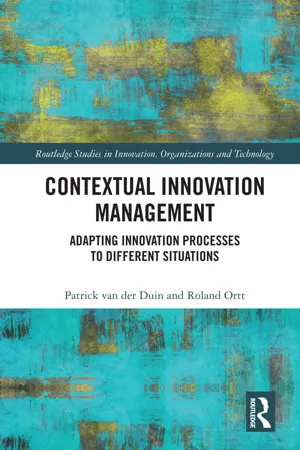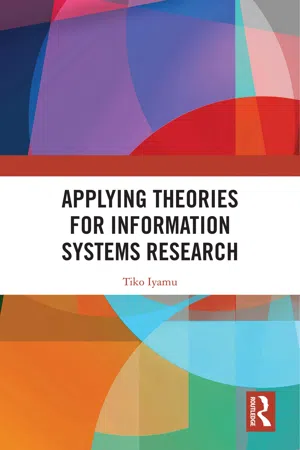Contingency Theory
Contingency theory in business suggests that there is no one-size-fits-all approach to management. Instead, it emphasizes that the most effective way to manage an organization depends on various situational factors, such as the environment, technology, and culture. This theory advocates for adapting management practices to fit the specific circumstances of a given situation.
8 Key excerpts on "Contingency Theory"
- eBook - ePub
Contextual Innovation Management
Adapting Innovation Processes to Different Situations
- Patrick van der Duin, Roland Ortt(Authors)
- 2020(Publication Date)
- Routledge(Publisher)
...3 From Contingency to Contextual The faith in success factors is persistent and widespread. In contrast, contingency-theory is a field in management science that adopts the premise that companies should adapt their organization and strategy to the environment or the context. Contingency Theory refutes the idea of a generic and fixed set of success factors. The fact that the environment changes means that companies have to change too. In the natural sciences, changes can be explained using a fixed and generally valid set of equations. In the social sciences, to which management science belongs, change means that different variables and different relationships between them become important, and hence the set of equations to explain the phenomena of change are themselves changing. The contingency perspective is a very relevant perspective to explore and develop specific innovation management approaches that fit particular companies and their environment. 3.1 Introduction: Contingency Theory The notion that business success in general and innovation success in particular can be explained by a general and fixed set of success factors is widely held. In this book, we argue that it is better to consider the way that organizations innovate as context dependent. This notion is theoretically and scientifically rooted in a management theory known as ‘Contingency Theory’. As is the case with many scientific theories, it is not always clear who developed the first ideas and hence can be called the grandfather or grandmother. A classical reference is the work of Paul R. Lawrence and Jay W. Lorsch who with their 1967 book ‘Organization and environment’ hoped to “renew interest in Contingency Theory” (Lawrence and Lorsch, 1967, p. xii). They refer to scientists such as T. Burns and G.M. Stalker (see section 3.5) and others (including the famous management scientist Alfred Chandler) who have laid down the foundation of Contingency Theory...
- eBook - ePub
Public Relations Theory
Capabilities and Competencies
- Jae-Hwa Shin, Robert L. Heath(Authors)
- 2020(Publication Date)
- Wiley-Blackwell(Publisher)
...4 Contingency Theory : Strategic Conflict Management Introduction The Contingency Theory of conflict management explains the dynamics of public relations practice as choosing the stance that best serves the interests of an organization, while at the same time following strategies that are dependent on the given situation—one that is often unfolding or in flux. This theoretical perspective suggests that public relations professionals adopt an “it depends” approach, defined as the most strategic response to changing circumstances. Contingency Theory may be defined as analysis of the dynamic interplay of parties on a continuum in a given set of internal and external circumstances over time. Contingency Theory has roots in observations about the behavior of individuals in corporate roles tracing back to the late nineteenth century. It developed at a time when serious scientific analysis of labor and management was undertaken in an attempt to understand work and supervision and make it a science. Later, following World War II, Contingency Theory became vital for analyses of various management styles. Most notably, the clinical psychologist Fred Fielder (1958, 1964, 1967) developed a sophisticated measurement system for assessing perceptions of common ground and psychological distance among coworkers. Fielder's contingency model of leadership showed how the interplay of multiple variables affected productivity in the workplace. In essence, Fielder proposed that effective managers change their leadership style to suit the situation at hand. His analyses suggested that work behavior could be described meaningfully only when combined with factors that were contingent—for example, how a manager addressed subordinates, or subcultures within working teams. This research countered the predominant “one size fits all” approach to management and organizational leadership...
- Patti Chance(Author)
- 2013(Publication Date)
- Routledge(Publisher)
...Although not definitive, this approach to Contingency Theory is useful to consider the connections among staff attitudes and personalities, a leader’s relationship with staff, and the nature of the tasks in which staff are engaged. It points out that there is not one ideal style of leadership, and that the effectiveness of a leader’s style will depend on the situation. Applications for School Leaders Understanding Contingency Theory will help school leaders ♦ Identify outside variables that impact a school ♦ Match leadership style with the needs of the school ♦ Consider the relationships among teachers’ personalities and attitudes, work-related tasks, and leadership style ♦ Understand the importance of short- and long-term contingency planning ♦ Appraise the impact of a school’s organizational structure on responses to external pressures and demands The Uncertainty Factor: Contingency Theory Applied to Organizations Contingency Theory, when approached from an organizational perspective, is related to the concept of open systems and the notion of loose coupling. Open system theory explains the relationships and exchanges between the organization and the external environment. Loose coupling refers to the connections among various units within the organization and describes units as interdependent, but at the same time each has its own identity, functions, and separateness. Contingency Theory examines the internal adjustments of the organization as it responds to events in both the external and internal environments (Hanson, 1979). Open Systems Open system theory emanates from the analogy of organizations as organisms. Thompson (1967/1996), in writing about open systems, referred to organizations in Darwinian terms: The complex organization is a set of interdependent parts which together make up a whole, which in turn is interdependent with some larger environment...
- eBook - ePub
Leadership of Higher Education Assessment
A Guide to Theory for Practitioners
- Matthew B. Fuller(Author)
- 2019(Publication Date)
- Routledge(Publisher)
...Contingency Theories state that the effectiveness of leadership depends upon the situation in which leaders and organizations find themselves. There are numerous factors, such as the nature of the task, the leader’s personality, and makeup of the group being led. In assessment practice, any number of contexts could influence how assessment is led. Prior engagement with assessment, new pressures for accountability data, finances, institutional reputation, or news media reports are just a few contexts assessment leaders face on a regular basis. Shifting demographics, student abilities upon entering the institution, or public opinions of higher education are a few issues facing higher education in general that may influence assessment leadership as well. Reflecting on how large social trends influencing higher education also influence assessment leadership can be useful for assessment leaders. Contingency Theories guide how assessment leaders like Chris can leverage contexts to better lead for assessment. CONTINGENCY AND SITUATIONAL THEORIES A brief word should be offered about an important dichotomy in leadership theory: Contingency and Situational Leadership. In this chapter we will use the nomenclature Contingency Theory to signal a set of theories wherein the leader’s style is dictated by organizational contexts. In contrast, Situational Theory is any wherein the leader has choosen his/her style given a set of organizational contexts. Contingency Theory focuses on the effectiveness of the leader within contexts. Most Contingency Theories hold that leaders will select preferred leadership styles to match the contexts in which they find themselves. The leader’s style will be influenced by a number of factors, such as their relationship with faculty and staff, availability or resources, or pressures to complete a given task. Therefore, the leader’s chosen leadership style is said to be contingent upon these factors...
- eBook - ePub
- Peter Spillard(Author)
- 2014(Publication Date)
- Routledge(Publisher)
...Chapter Three THE CONTINGENCIES Introduction: The Nature of Contingency Theory This chapter will examine the contingencies that affect the ultimate choice of organizational structure from among the possibilities discussed in Chapter Two ; recognizing, of course, that as the balance of these contingencies change, then so ought the organizational solution. Galbraith 1, in introducing the Contingency Theory of organization, says:- “This theory is based on two conclusions drawn primarily from large-scale empirical studies. (a) There is no best way to organize. (b) Any way of organizing is not equally effective. Thus, we can observe a wide range of effective organizations but their differences are not random. The form of organization makes a difference. All of which suggests a new set of questions. On what factors does the choice of organization form depend? What are the characteristics of organizational contexts which appear to make a difference?” Khandwalla 2 continues:- “The basic idea of the contingency theorists is that the nature of the organization’s technology, its size, its legal incorporation, the character of its markets and other factors confront the organization with some opportunities as well as constraints and problems and therefore set the tone of the organization’s adaptation as revealed by its structure. The idea is an elaboration of the biologist’s functionalist view of the adaptation of living forms to their environment.” The work of Woodward, Burns and Stalker, Lawrence and Lorsch, Thompson, Chandler and Mintzberg has all helped to initiate discussion of the significance and nature of the contingencies that shape the ideal organization. It seems sensible to proceed by constructing a model which attempts to plot the extent of the contingencies existing in addition to those factors already identified in Chapter 1. These comprise the independent variables which affect the dependent variable labelled “organizational structure”...
- eBook - ePub
- Vibrant Publishers, Dr. Carrie Picardi(Authors)
- 2021(Publication Date)
- Vibrant Publishers(Publisher)
...Situational and Contingency Leadership While an array of leadership best practices and approaches do exist for leaders and managers to successfully implement with their respective group and setting, there is no single answer or formula for being an impactful leader in every situation and context. Different situations will require different leadership styles and as needs and circumstances vary and shift, a leader must adapt their behaviors accordingly to meet those changing needs and expectations. An effective leader will have an awareness of internal and external factors that influence changing circumstances, and understand how to apply their traits, knowledge, skills, and abilities to act in a relevant and appropriate manner in response to the unique requirements and demands of a particular situation...
- eBook - ePub
- Lex Donaldson(Author)
- 2001(Publication Date)
- SAGE Publications, Inc(Publisher)
...9 Neo-Contingency Theory S o far we have remained within the traditional framework of Contingency Theory research. However, there are certain problems with the traditional view. In this chapter we identify these problems and suggest how to resolve each of them. This leads to a revised form of Contingency Theory that may be termed neo-Contingency Theory. Contingency Theory is traditionally concerned with organizational performance and in that broad sense is consistent with economics. However, Contingency Theory has mostly not drawn much on economics and tends to remain isolated from it. Some attempts have been made to import elements of economics into organizational theory more generally, such as agency theory (Jensen and Meckling 1976) and transaction costs economics (Williamson 1975). However, these have proven controversial (Barney 1990; Donaldson 1990a, 1990b; Ghoshal and Moran 1996; Moran and Ghoshal 1996; Williamson 1996). Moreover, they deploy only a narrow range of economic concepts. In our reformulation of Contingency Theory we shall draw on economics and the related discipline of finance, at numerous points, to gain conceptual insights. In so doing, we will utilize aspects of economics different from those used to date in organizational theory. We hope that in this way we may break some new ground and encourage an infusion of ideas from economics and finance into organizational theory. Problems in Traditional Contingency Theory In the present book and elsewhere (Donaldson 1985, 1995a, 1996a) we have defended Contingency Theory from criticism made against it. However, there are three problems that exist within Contingency Theory, and these have not been widely canvassed to date. As we have seen, traditional Contingency Theory holds that an organization in misfit will change its structure to move into fit with its contingency (e.g., Burns and Stalker 1961)...
- Tiko Iyamu(Author)
- 2021(Publication Date)
- Routledge(Publisher)
...It has been emphasised that ‘reality is socially constructed’ (Mertens, 2005). Thus, interpretivist researchers tend to rely upon views and opinions of participants about the situation they experience and around them relative to the phenomenon being studied (Creswell, 2003). As the research evolves, it is somehow no longer so much of benefit and significance to rely wholly on an interpretivist approach as a single entity for data analysis. Otherwise, many analyses will continue to be horizontal and overzealous, as opposed to succinct and vertical, and deeply rooted in sense making and outcome. In recent years, IS studies have been increasingly underpinned by sociotechnical theories, such as the Contingency Theory (CT). The theory is most useful, particularly in areas such as contingencies and organisational performance enhancement, which in other theories play little or no part in coverage. CT attempts to address the interrelationships within organisational systems or subsystems as well as an environment. Donaldson (2001) defines CT as a ‘variable that moderates the effect of organisational characteristics on organisational performance’. Betts (2003) argues that the CT is optimal, depending on the nature of the environment associated with an organisation. Primarily, CT is concerned with the role of structure in organisational performance. From the perspective of CT, Blanton, Watson, and Moody (1992) developed the contingency model, which consists of environment, structure, performance, and strategy, as shown in Figure 6.1. The social environment encourages employees to associate value with their jobs and perform in such a way that the organisation is able to operate strategically, tactically, and spontaneously. According to Husted (2000), the contingency model permits strategies and structures to be aligned with the organisation’s objectives to achieve enhanced performance. Figure 6.1 Contingency model (Blanton et al., 1992). Source: Blanton et al...







